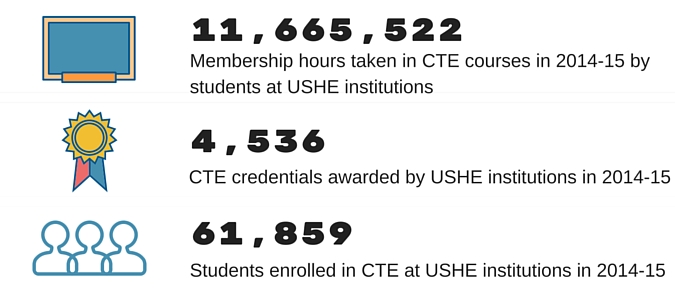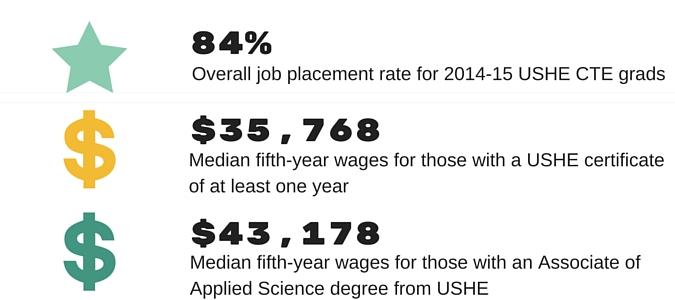Career and Technical Education (CTE) consists of technical training and education in shorter intervals–from less than one year to two years–and prepares students for specific skills needed to enter the workforce. By providing over 70 percent of CTE in Utah, the Utah System of Higher Education (USHE) plays a critical role in bringing CTE to all regions of the state. USHE works closely with business and industry leaders to develop and deliver relevant programs specifically tailored to local workforce development needs. According to the 2015 USHE Report on CTE:
CTE is a key ingredient to meeting the needs of Utah’s economy. During the 2014-15 academic year, CTE comprised 23 percent of the total undergraduate courses offered at USHE institutions, and accounted for 16 percent of undergraduate degrees and certificates awarded.
% Career and Technical Education (FTE) by Institution (2014-15)
What types of CTE credentials does USHE offer?
Seven of the eight USHE institutions offer three primary types of CTE credentials:
- Associate of Applied Science (AAS) degree – Designed to lead students directly to employment requiring two years of preparation. The AAS degree includes a core set of general education, preparing students with a solid basis in composition, computation, and human relations. In some cases, AAS programs can serve a dual purpose to prepare students for the workforce while serving as a pathway to a bachelor’s degree.
- Certificate of Completion – Awarded for completion of programs that are typically one year in length and that prepare students for employment. Certificates of Completion also have a general education component.
- Certificate of Proficiency – Short-term training programs less than one year in length that prepare students for specific employment skills.
Earnings and job placement for USHE CTE graduates
Partnering with industry, streamlining credit, and getting students to the workforce quickly
For the past several years, each of Utah’s eight regional CTE councils have met regularly to identify potential certificate programs that could be developed or strengthened within each region. This partnership approach focuses on short-term certificates (16-29 credits) as a first step for students seeking a college credential, or as a short-term option for older adults retooling for a career change or career advancement. In fact, 89 new certificates have been developed as a result of direct collaboration with business and industry throughout the state.
CTE concurrent enrollment
28,549 Utah high school students enrolled in a college course available through concurrent enrollment during the 2014-15 academic year. Of these, 60 percent (17,199) enrolled in a least one CTE course. CTE concurrent enrollment accounts for over 38 percent of the total concurrent enrollment credit hours earned.



